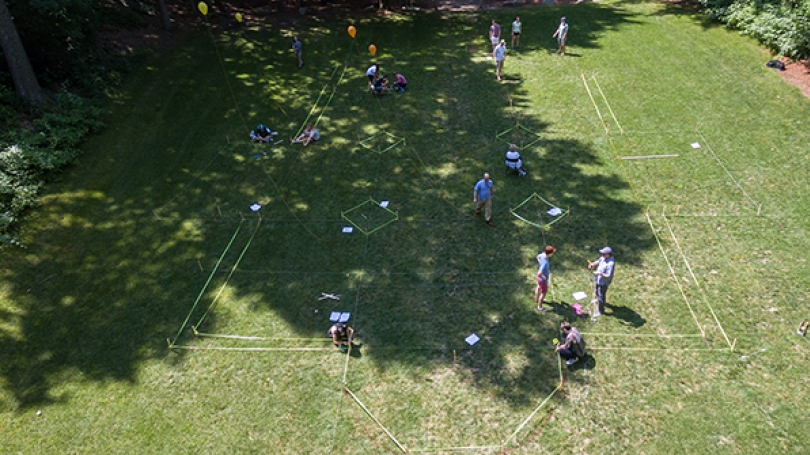
- Undergraduate
- Foreign Study
- Careers & Opportunities
- News & Events
- Visual Resources
- People
Back to Top Nav
Back to Top Nav
Back to Top Nav
Back to Top Nav
On a sunny day toward the end of summer term, about a dozen students from Assistant Professor Nicola Camerlenghi’s “Art History 34: Castles, Cloisters and Cathedrals” class meet on the Bema. Their goal: Lay out the footprint of a 13th-century French gothic church using only technology that would have been available to builders in the Middle Ages.
Joining them for the day as “master mason” is Michael Davis, a professor of art history at Mt. Holyoke College and an expert on gothic architecture. “We’re going to try to get into a medieval mindset,” Davis tells the class, passing out plans for the Basilica of Saint Urban of Troyes, which Pope Urban IV commissioned in 1262 and whose floor plan the class will attempt to replicate within two hours.
“What I want to impress upon you is that this is experimental,” Davis says. “I have worked out a certain sequence of steps, but if the light bulb goes on and you see a more efficient way to accomplish the same thing, please put your innovation into practice.”
For tools, the students use string, wooden stakes, makeshift compasses, mallets, and basic geometry to measure angles and distances, beginning by marking out an 18-foot-by-18-foot square for the church’s central crossing—a half-scale rendering of the actual basilica’s crossing, which is 36 by 36 feet.
“Any symbolic bells going off there?” Davis asks. For the church’s designers, he explains, the number 6—the square root of 36—is an example of a “perfect number,” because its factors (3, 2, and 1) add up to the number itself. “Don’t you feel the hair on the back of your neck starting to kind of rise?”
Pope Urban himself may have had some input in the dimensions of the crossing, Davis says. “This is one place I can imagine that the Pope would have said, ‘I want a perfect building.’”
“They were trying to connect themselves to heaven, to build a kind of heaven on Earth,” says Camerlenghi. “So how do you do that? Well, you try to replicate the perfection of the cosmos, using geometry as a guiding principle.”
https://news.dartmouth.edu/news/2017/08/humanities-laboratory-recreating-gothic-church?utm_source=Dartmouth+News+Weekly&utm_campaign=ac8e297567-dartnews_weekly_2017_08_31&utm_medium=email&utm_term=0_0b7afd736b-ac8e297567-391352573